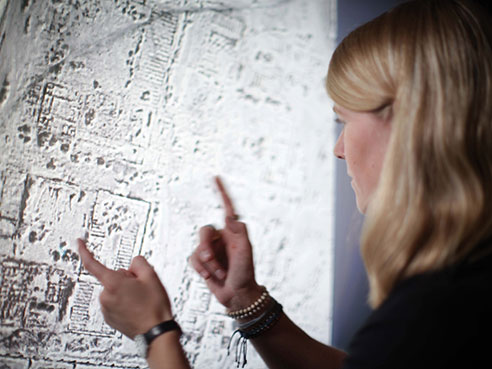Written by: Sarah Parcak, Ph.D.
Media contact: Alicia Rohan, arohan@uab.edu
Editor’s note: Sarah Parcak, Ph.D., is a professor of anthropology at the University of Alabama at Birmingham, the 2016 TED Prize winner and president of Globalxplorer. This Op-Ed was originally written for The New York Times.
 Parcak uses satellite imagery to map and identify ancient sites.The tragedy that engulfed the 200-year-old National Museum of Brazil in Rio de Janeiro on Sunday night, turning up to 20 million of its holdings into dust, is an urgent reminder of the need for better safekeeping measures at museums around the world. To put what happened in perspective: It is as if the entire collection of the British Museum disappeared, twice over, in the blink of an eye.
Parcak uses satellite imagery to map and identify ancient sites.The tragedy that engulfed the 200-year-old National Museum of Brazil in Rio de Janeiro on Sunday night, turning up to 20 million of its holdings into dust, is an urgent reminder of the need for better safekeeping measures at museums around the world. To put what happened in perspective: It is as if the entire collection of the British Museum disappeared, twice over, in the blink of an eye.
The fire ignited for unknown reasons. But many Brazilians are blaming their government, and some have taken to the streets in protest. After years of declining federal funds, the museum staff had requested urgent maintenance funds from the country’s National Development Bank. In June, the money was disbursed but not in time to install the planned update to the museum’s fire equipment, which lacked a sprinkler system.
Right after the fire erupted, haunting images of panic-stricken museum workers with arms full of museum objects started to circulate on social media and in news outlets. One video showed some of them carrying jars of preserved specimens outside, as firefighters raced back in to save what they could.
I have seen firsthand the museum’s invaluable holdings. In 2014, I visited with two archaeology friends — a bio-archaeologist and a paleoanthropologist — and we just stood, slack jawed, as we went from room to room. One of the oldest skeletons in South America, nicknamed Luzia, from 11,500 years ago, was in storage; a replica showing a complete reconstruction of her head was on display. An entire room was filled with Egyptian treasures, including the brightly painted coffin containing the mummy of Sha-Amun-In-Su, dating to about 750 B.C. Innumerable priceless objects from diverse indigenous cultures in Brazil and other parts of Latin America could be seen in glass cases. There were frescos from Pompeii in the museum’s Mediterranean collection. The museum housed an extraordinary library with nearly 500,000 books, 2,400 of which were rare, and a natural history collection including dinosaurs, insects and meteorites, curated from countless expeditions by scientists and explorers.
According to Anna Roosevelt, professor of anthropology at the University of Illinois at Chicago, “The museum had collections from the early explorations to the most recent investigations, comprehensive collections that show the history of museums, of exploration and of science in Brazil.” The fire, she said, is “a catastrophe for South American natural science and anthropology.” Fortunately, the library was spared — it was not in the main building — along with parts of the vertebrate collections; but at present it is estimated that only 10 percent of the collection survived.
As the fire raged, friends and colleagues in Brazil sent tweets expressing their anger and sense of hopelessness. Marina Amaral, a Brazilian digital colorist, wrote, “I sincerely believe that the loss of any museum is a loss to civilization as a whole.”
But Brazilians are not standing idly by. On Sept. 3, many gathered, arm in arm, surrounding the building, hugging the remnants of the museum with human bodies, as if to will it back into existence. Efforts are underway to crowdsource photographs from former visitors so that the museum’s offerings can be virtually reconstructed.
Careful excavation in the coming weeks by trained museum professionals and conservators may reveal more parts of the collection that survived. There is some hope, but a far bigger lesson for the world. Museum collections globally have similar risks of loss from fire, flooding and natural disasters, and many receive limited funding from governments that do not value cultural heritage and natural history. There are disaster management courses run by the Smithsonian Institution’s Cultural Rescue Initiative, and some museums have effective plans in place.
As the fire at Hampton Court Palace in Britain in 1986, and the infrastructural damage to the New Orleans Museum of Art following Hurricane Katrina in 2005, and to the multiple museums in Nepal following an earthquake and its aftershocks in 2015 show, the risk of fire and natural disasters is not contained to one region or country. Governments throughout the world need to place a premium on these irreplaceable storehouses of human and ecological history. A full-scale assessment of building security, disaster management plans, and protection against fires and flooding must be done as soon as possible. All museum collections need to be inventoried if they have not already been, with the data secured in the cloud, in case something similar — or worse — happens.
These museum collections are nothing less than the keys to understanding not only our past but our future as well. They help us to understand how past cultures adapted to changing worlds and have much to teach us as we adjust to shifting climates, new technologies and the possibility of living in space. Their preservation should be a top priority for anyone who cares about our collective humanity.